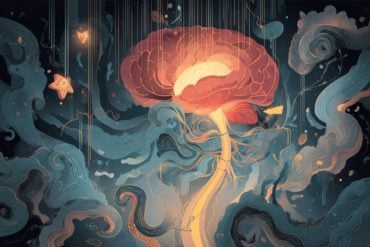Summary: Sleep spindles—brief bursts of brain activity crucial for memory and sleep stability—are guided primarily by short-term timing patterns lasting less than 15 seconds. Researchers found these patterns are highly individualized, consistent across nights, and change with age, outweighing the influence of other factors like brain rhythms or sleep depth.
This discovery challenges traditional views, shedding light on how sleep spindles form and their links to aging, memory, and conditions like Alzheimer’s or schizophrenia. The study opens doors for targeted research and potential therapies aimed at improving brain health.
Key Facts:
- Dominant Factor: Short-term timing patterns over 15 seconds determine over 70% of spindle timing variability.
- Individualized Patterns: Spindle timing is unique to each person and changes with age.
- Broader Impact: Findings may enhance understanding and treatment of disorders like Alzheimer’s and schizophrenia.
Source: Brigham and Women’s Hospital
Michael J. Prerau, PhD, of the Division of Sleep and Circadian Disorders at Brigham and Women’s Hospital, is the senior author of a paper published in PNAS, “Individualized temporal patterns drive human sleep spindle timing”.
How would you summarize your study for a lay audience?
Our research focuses on sleep spindles—short bursts of brain activity during sleep that are crucial for stabilizing sleep and supporting memory.
Sleep spindles are of great interest because changes in spindle activity have been linked to many neurodevelopmental and neurodegenerative disorders, such as Alzheimer’s disease and autism.
While many factors influence when and how these spindles occur, such as sleep stages or brain rhythms, we discovered that short-term patterns, like a musical rhythm spanning just a few seconds, play the most dominant role in determining their timing.
These patterns are unique to each person, much like a fingerprint, and they change with age.
Our work offers a new way to understand how spindles are generated and how they may be linked to memory, aging, and conditions like neuropsychiatric disorders.
What knowledge gap does your study help to fill?
If we want to use spindle activity to diagnose and treat diseases, it is vital to understand what systems most influence spindle production.
Factors such as sleep depth, slow wave activity and long-term patterns have been linked to spindle activity. However, it was unclear how these factors interact and how important each one is to spindle generation.
Our study helps fill this gap by demonstrating that short-term patterns of past spindle activity—spanning less than 15 seconds—are the most influential factor.
This new understanding challenges conventional ideas and provides a clearer picture of how individual spindles are generated.
What approach did you use?
We analyzed sleep data from over 1,000 participants from the National Sleep Research Resource, using advanced statistical modeling to evaluate the combined effects of various factors—such as brain rhythms, sleep stages and past spindle activity—on spindle timing.
This approach allowed us to rigorously compare the importance of each factor and uncover their interactions.
By focusing on the moment-to-moment dynamics of spindle production, we could pinpoint the role of short-term timing in shaping these events.
What did you find?
We found that short-term timing patterns— the history of spindle activity over the previous 15 seconds—were the primary determinant of spindle timing, accounting for more than 70 percent of its variability.
This influence greatly outweighed other well-known factors, like slow oscillation brain rhythms or sleep depth. Moreover, these short-term patterns were highly individualized, consistent for each person across nights and changed with age.
We also showed that while brain activity, like cortical up/down states, play a role, they may not be as essential to spindle production as previously believed.
Instead, spindle timing seems to be governed by a combination of different internal and external factors, each combining to make windows of opportunity for spindles to occur.
What are the implications?
Our findings highlight that short-term timing patterns are more important for sleep spindle production than previously thought.
These patterns provide a new target for better understanding how sleep supports memory and how changes in sleep spindles might be connected to aging or conditions like Alzheimer’s and schizophrenia.
What are the next steps?
Moving forward, we will expand our analysis to look at other factors that influence spindle production across different brain regions. By doing so, we hope to develop a more complete understanding of spindle mechanisms and their drivers.
This deeper insight could help identify how spindle patterns differ in individuals with neurodevelopmental or neurodegenerative disorders, paving the way for improved diagnosis and potential new treatment approaches.
We would like to express our deep gratitude toward Dara Manoach for access to the data from Wamsley et al.
Funding: The National Sleep Research Resource was supported by the National Heart, Lung, and Blood Institute (R24 HL114473, 75N92019R002).
About this sleep and neuroscience research news
Author: Cassandra Falone
Source: Brigham and Women’s Hospital
Contact: Cassandra Falone – Brigham and Women’s Hospital
Image: The image is credited to Neuroscience News
Original Research: Open access.
“Individualized temporal patterns drive human sleep spindle timing” by Michael J. Prerau et al. PNAS
Abstract
Individualized temporal patterns drive human sleep spindle timing
Sleep spindles are cortical electrical oscillations considered critical for memory consolidation and sleep stability. The timing and pattern of sleep spindles are likely to be important in driving synaptic plasticity during sleep as well as preventing disruption of sleep by sensory and internal stimuli.
However, the relative importance of factors such as sleep depth, cortical up/down-state, and temporal clustering in governing sleep spindle dynamics remains poorly understood.
Here, we analyze sleep data from 1,025 participants, statistically modeling the simultaneous influences of multiple factors on moment-to-moment spindle production using a point process-generalized linear model framework.
Results reveal fingerprint-like timing patterns, characterized by a refractory period followed by a period of increased spindle activity, which are highly individualized yet consistent night-to-night, with increased variability with age.
Strikingly, short-term (<15 s) temporal patterns of past spindle history are the main determinant of spindle timing, accounting for over 70% of the statistical deviance—surpassing the contribution of factors such as cortical up/down-state (slow oscillation phase), sleep depth, and long-term history (15 to 90 s, including ~50 s infraslow activity).
Short-term history has a statistically significant influence in over 98% of the population, suggesting it is a near-universal feature of spindle activity. Short-term history and slow oscillation phase exert independent effects on spindle timing.
Our results establish a robust statistical framework to examine abnormalities in sleep spindle timing observed in neurological disorders and aging, as well as the relationship between individualized sleep spindle timing, cognition, and sleep stability.








